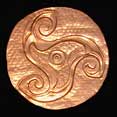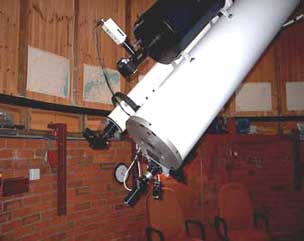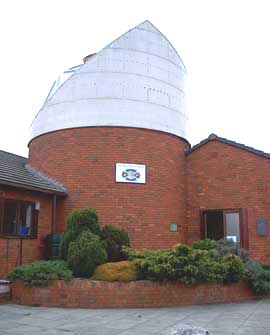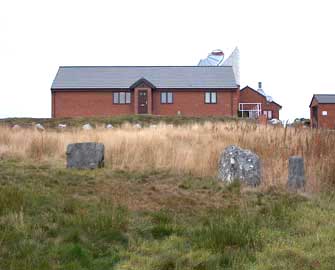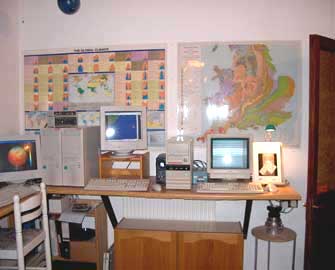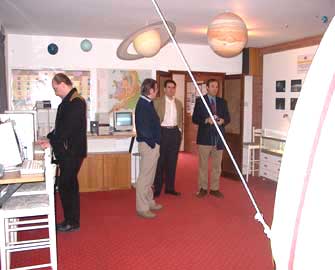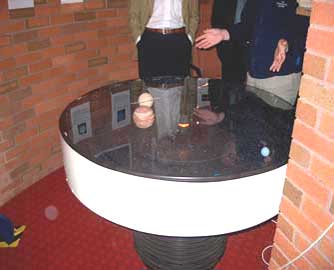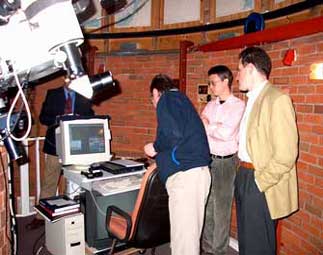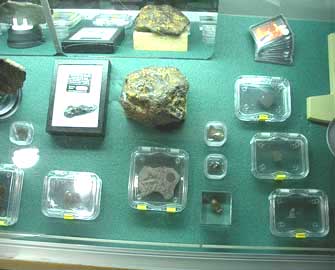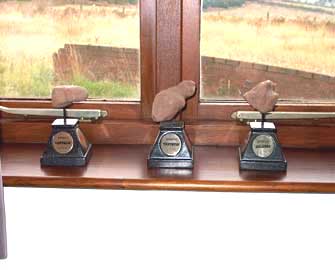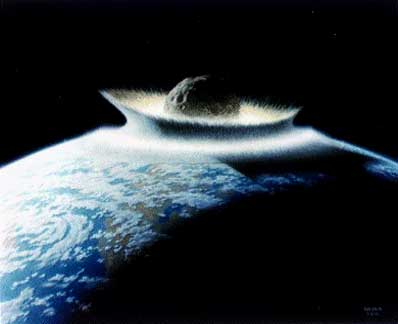|
|
|
|
![]()

SpaceGuard UK
–
International SpaceGuard Information Centre
–
text translation service for many worldwide languages
Space Weather Radio
live sounds from the near-Earth environment…
Today is
The SpaceGuard Centre is a working astronomical observatory located near Knighton, Powys, in mid-Wales. It was
opened on September 29 2001 by Sir Patrick Moore, and was the first establishment of its type. It is also near to the Wales/England border and to the Offas Dyke path that runs the length of the border area. Sited at the top of a hill, the observatory offers outstanding panoramas in all direction, and a clear 360° horizon. It is home to
SpaceGuard UK, which was established in January 1997 as an information node for those concerned with Near Earth Objects (NEOs), and the threat they pose to both human civilisation and to life on Earth in general.
|
|
Since then, the SpaceGuard Centre has become home to the International SpaceGuard Information Centre, and is also the hub of the Comet and Asteroid Information Network (CAIN). They all work closely with astronomical organisations around the world, including NASA, the European Space Agency, ESA, as well as with the British National Space Centre.
|
The Rome-based SpaceGuard Foundation had selected SpaceGuard UK to be the official international mouthpiece of the many scientists around the world that scan the skies for potentially hazardous asteroids and comets. Its Board of Directors issued the following statement:
“The SpaceGuard Centre’s parent organisation (SpaceGuard UK), led by Jonathan Tate, has become the leading public outreach organisation dealing with NEOs in the UK and probably the world.
The SpaceGuard Foundation, formed as a result of decisions taken by Commission 20 of the International Astronomical Union and the IAU Working Group on NEOs, has appointed The SpaceGuard Centre in Powys, Wales as the International SpaceGuard Information Information Centre.
Given the multi-disciplinary nature of the subject and its complexity it is impossible for any other orgaisation to provide the knowledge, experience and contacts that The SpaceGuard Centre can offer. The SpaceGuard Centre has established an international reputation that cannot be duplicated”
.
Since the events of July 16 – 22 1994, when the remnants of a fragmenting comet,
P/ Shoemaker-Levy 9, bombarded the surface of Jupiter causing fireballs many times the size of our own planet, the impact hazard has been receiving increasing media attention. But some of the media coverage has been grossly
over-sensationalised, especially the newspaper headlines – while at the same time, the ‘impact hazard’ is also becoming a platform for science education in many disciplines, as earth scientists generally are beginning to accept the fact that our fragile planet can no longer continue to be viewed as if it is somehow ‘isolated’ from the solar system environment in which it exists.
In response to these developments in our understanding of the ‘near-earth’ environment in recent years, and in order to better inform the general public in a much less sensationalist way than many newspapers have done, the SpaceGuard Centre, run by Jonathan (Jay) and Anne Tate, is open to visitors for daytime educational tours, which last about an hour and a half, and also for evening educational tours, which can last a lot longer if the sky is clear.
As Anne Tate is a former primary school teacher, having worked for the British Forces Education Service in the UK and Germany, and has also acquired qualifications in adult education in recent years, she is ideally suited for her educational role at the SpaceGuard Centre. With a special emphasis on school parties, and with access to the most up-to-date information about asteroids and comets available anywhere in the world, it is hoped that the educational resources they are developing will help generate sufficient interest in the schoolchildren who visit the centre for some to begin considering careers as the next generation of scientists. Hard work, but with the real promise of an exciting career as space exploration and discovery continue to develop new 21st century disciplines such as astrobiology and
Based at the former Powys Observatory, SpaceGuard UK is now the focus in the UK for a variety of studies into the threat posed to the Earth by collisions with asteroids and comets. The SpaceGuard Centre is also superbly equipped with a variety of old and new equipment, as well as a number of educational displays of meteorite samples from impact sites around the world – including an extremely rare piece of a genuine Martian meteorite. Visitors can expect to enjoy access to:
Telescopes:
|
morien institute |
* 13″ apochromatic refractor
* 4?” refractor complete with Solar hydrogen alpha filter
* 10″ Meade f/6.3 Schmidt-Cassegrain
* 8″ Celestron f/10 Schmidt-Cassegrain
* 90mm. “Goto” Maksutov-Cassegrain
* as well as various amateur instruments |
Camera Obscurer:
This optical device projects a picture of the surrounding countryside, or the sky, onto a circular floor. With a 13″ electrically-controlled optical system this is the largest Camera Obscura in Europe (possibly the world). Focussing is achieved by moving the hydraulic floor vertically up and down.
|
morien institute |
morien institute |
Outside the SpaceGuard Centre there is a recently-made circle of large stones laid out after the ancient megalithic tradition. The stones have been aligned to various significant points on the distant horizon marking the risings and settings of the sun at the equinoxes and the solstices. Using such rude-stone instruments as ‘backsites’, ancient skywatchers were able to accurately calculate the rising points not only of the sun, moon and planets, but also of many 1st and 2nd magnitude stars using both local and distant feature-rich horizons as their ‘foresite’ markers.
The accuracy of these ancient skywatching aids has astounded arch?ologists, mathematicians and astronomers alike, and for the last 300 years none have been able to understand, or even explain, the ‘motivation’ of those peoples whose megalithic engineering achievements must have involved whole communities for many decades. Mainstream archaeologists, where they do accept that ancient peoples were competant skywatchers, often portray those early agricultural peoples as concerned only with building crude ‘calendars’ for the presumed purpose of regulating planting and harvest times.
But, as well as observing the Sun and the Moon, the Bronze Age megalithic astronomers in particular had much higher priorities for observation. These were rising points of the ‘radiants’ of what, at that time, were the very real, life-threatening,
‘Taurid-Arietid meteorite-storms’, which were feared by ancient peoples everywhere.
During the Neolithic period, and continuing into the Bronze Age and beyond, the Earth was encountering streams of debris which resulted from the fragmentation of a giant comet that had come into the inner solar system 10,000 years or more before. Meteor showers at that time were generally of ‘storm’ severity, and evidence is accumulating that many Bronze Age societies in many parts of the world collapsed simultaneously following bombardments of cometary debris which appeared to be coming from the area of the sky containing the constellations Taurus and Aries.
The ‘Taurid-Arietid’ meteor streams still contain many large boulders, as well as dust-grains of all sizes, right down to the sub-micron dust which can stay in the upper atmosphere for many years causing temperatures to drop, crops to fail as photosynthesis shuts down, causing a “Cosmic Winter” that could last for decades and usher in a ‘Dark Age’ …
Planetarium:
In the planetarium there is a ‘mini-dome’ with seating for 25 people. An accurate representation of the night sky is projected onto the domed ceiling.
Earth Observation & Weather Station:
This consists of a suite of sensors which include a real-time satellite image downlink, and a ‘seismic station’ – a computerised seismograph with real-time display.The location of the observatory makes it an ideal platform for this instrument. Whilst earthquakes can be detected the equipment could also detect ‘meteorite impacts’ as well.
|
morien institute |
morien institute |
Orrery:
|
morien institute |
This moving mechanical model of the Solar System shows the planets in their orbits around the Sun. Many people believe that the word ‘orrery’ is derived from the word ‘orbit’, simply because this is what it demonstrates.
But mechanical models of the solar system were invented around AD 1700 by a man named George Graham, and according to one source they: ” … have been called ‘orreries’ ever since the English instrument maker John Rowley named a copy he made (1712) of Graham’s machine ‘The Orrery’ in honour of Charles Boyle, Earl of Orrery”.
|
Robotic Telescopes:
The SpaceGuard Centre is linked via the Internet to three large robotic telescopes. One is in Hawaii, another is in the Canary Islands and the third is in Australia. These telescopes are operated by the National Schools Observatory and the Faulkes Telescope Project. In the image below you can see SpaceGuard UK Director, Jonathan (Jay) Tate, demonstrating the computerised controls of the large 13″ apochromatic refractor to Dr David Asher and Dr Benny J. Peiser, during the recent “Neo Awareness Symposium” held at the SpaceGuard Centre in Knighton, mid-Wales, on October 13th 2003.
|
morien institute |
The National Schools Observatory is a major web-based resource that allows UK schools to use world-class astronomical telescopes sited all around the world. Observing time has been specially reserved on these professional instruments for schools. Working with the resources developed by the Schools’ Observatory, students can prepare and carry out their own astronomical research and share in the excitement of discovery.
|
The Faulkes Telescope Project will allow students in schools and colleges in the United Kingdom, Hawaii and Australia to make astronomical observations with a research-class robotic telescope, direct from the classroom via the Internet. The telescope on the mountain of Haleakala, in Hawaii, is now in final testing by the manufacturer, TTL. The CCD camera has been installed and the first test images have been acquired. The Project intends to take delivery of the telescope from TTL before the end of December (2003) and will then start its own commissioning programme.
As well as all these facilities, lectures and presentations on a variety of astronomical subjects can be booked through the SpaceGuard Centre, which also houses a unique collection of displays of meteorites, tektites, and models of asteroids …
Displays of Meteorites, Tektites and Asteroid Models:
|
morien institute |
morien institute |
There are a number of SpaceGuard organisations around the world that have been set up over recent years. Most are affiliated to the Rome-based Spaceguard Foundation based in Rome. Each of these organisations have developed links with researchers in universities and non-profit research groups in their respective areas, and between them their web-sites contain the most comprehensive links to all these other organisations.
As of October 2003, SpaceGuard UK and the SpaceGuard Centre in Kighton, mid-Wales, has been selected by the
SpaceGuard Foundation to become its mouthpiece in public outreach. It is now the:
International SpaceGuard Information Centre
|
a painting by Donald E. Davis for NASA |
Impact Craters |
Skywatching Calendar |
Comets, Asteroids & Spaceguard Projects
Space Weather Radio
live sounds from the near-Earth environment…
|
|
2019 Skywatching Calendar |
News & New Discoveries
Marine Archaeology News 2020 |
Astro-Archaeology News 2020
The Morien Institute
1996-2020
